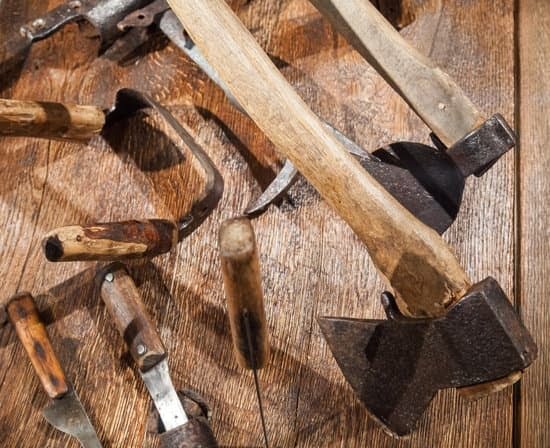Introduction
Sharpening stones are abrasive tools used to hone the edges of metal and woodworking tools, such as knives, chisels and plane blades. They come in two basic types: natural stones, which include waterstones and oilstones; and artificial or man-made stones such as diamond plates and ceramic stones. Each type serves a different purpose when sharpening and maintaining tools for professional use or home projects.
When it comes to sharpening tools for woodworking, natural stones tend to be the go-to choice of professionals and more experienced craftsmen. Waterstones are considered to be the best sharpening stone option overall due to their combination of high quality abrasives and smoothness in honing steel surfaces. Waterstone sharpeners work best when wet with water but can also be used dry with excellent results. Despite its low cost, oilstones are another great option due to the level of finesse they lend when creating razor-sharp edges on woodworking tool cuts. Diamond grinding wheels offer superior stability while providing more aggressive cutting action than either waterstone or oilstone options in certain cases.
Ceramic whetstones provide an alternative solution that causes less wear on tool blades; however, some users complain about lack of uniformity in finishing off cuts using this material compared with other types of sharpening stones. An advantage that all sharpening stone materials have is longer service life when adequate care is taken during cleaning and storage processes.
Key Benefits of Using a Sharpening Stone for Woodworking
A sharpening stone for woodworking is a great tool to have for any craftsperson. It can make sure that your blades are as sharp as possible, reducing the amount of time it takes to complete a job and providing you with a more precise cut. A sharpening stone also helps protect your tools against rust and wear, ensuring they last longer. It is much easier to sharpen a blade with a sharpening stone than it would be to sharpen it by hand, making it an invaluable addition to any workshop. Additionally, using a sharpening stone rather than alternatives such as steel files or sandpaper reduces the risk of damaging delicate surfaces, allowing the woodworking project to look its best. By using a sharpening stone, woodworkers can prevent their tools from becoming dull prematurely, which ultimately leads to better finishes and higher yields on projects. On top of all this, regular use of a sharpening stone can extend the life of expensive tools; making them well worth the initial investment.
Overview of Different Types of Sharpening Stones For Woodworking
Sharpening stones come in a variety of types, sizes, and materials. Each type has its own set of advantages and disadvantages that should be taken into consideration when selecting the best sharpening stone for use on woodworking projects. Coarse stones, such as carborundum or aluminium oxide, offer fast removal of material and can rapidly sharpen tools; however, they can cause stock to lose dimension quickly. Finer grain stones, such as pocket stones or Arkansas stones, are great for honing and refining edges but tend to require more time to work with than their coarser counterparts. Waterstones also provide a very fine edge although they may be fragile and require more maintenance. Natural stones like Novaculite or hard black Arkansas are often prized for their ability to produce less deformity in the metal surface being sharpened; however, these softer more porous materials may wear down quickly when used on both harder steels and exotics woods due to their quickly diminishing grit size. A good knowledge of which grain is best for each specific application will help in selecting the ideal sharpening stone for any woodworker’s shop. Understanding how different grains perform when combined with higher grit numbers also allows one to produce significantly sharper finished edges faster than ever before.
How to Select the Right Sharpening Stone for Woodworking
Selecting the right sharpening stone for woodworking can be a challenge. There are numerous types, sizes and brands available which can make choosing the best tool an intimidating task. Fortunately, if you narrow down your choices by considering criteria such as budget and desired results, it’s easy to find one that will work for your needs.
First and foremost, consider what type of material you plan to use on your sharpener stone. Natural stones like water stones are more efficient and powerful than synthetic varieties like diamond stones, but they may require more upkeep in terms of keeping them clean since they absorb metal particles while they sharpen out steel tools. Synthetic stones typically require less maintenance since they are designed to repel metals better and have an overall longer lifespan.
Consider also the size of the stone for your needs, as most sets come with two or more options allowing for larger projects or deeper cuts using a bigger stone size than a smaller one. You should also take into account how frequently you plan on using the sharpening stone in order to determine how hard-wearing it must be in order to withstand frequent use over time. Moreover, price is always an important factor when seeking out quality products; there are simpler versions at lower prices but investing in higher grade stones will offer a better value in the long run since it won’t need replacing abruptly due to lack of durability. To sum up, narrowing down your choices by taking all these criteria into account should help you identify –and select–the best sharpening stone for woodworking projects!
Pros & Cons for Different Types of Sharpening Stones for Woodworking
Oil Stones: Oil stones are one of the oldest forms of sharpening stones. They are made of natural materials such as Arkansas and India stones, as well as synthetic models. The advantage to using oil stones is that they break down relatively slowly, giving you time to reset your finely honed edge during sharpening sessions. The downside is that they can be tough to maintain due to needing to regularly clean, re-oil and flatten the surface.
Water Stones: Water stones are often used in woodworking because they provide a very fine cutting action and extra-fine finish. These stones require little maintenance but may need to be flattened every few sharpenings. They also typically come with higher purchase prices than oil stones.
Diamond Stones: Diamond stones offer fast material removal which makes them ideal for aggressive metal removal or reshaping an old cutting edge. Often type of stone is a two or three piece combination with either a course or medium grit side and a finer finish side depending on the model. The pros include extreme durability and long service life, no oiling required, faster than other types of stone, non corroding composition, flatness retention for multiple uses and lack of glazing issues common in water stones; however, diamond stones are more expensive compared to other stone types so may not be cost effective for everyone’s budget.
Care & Maintenance Tips for Sharpening Stones
Sharpening stones are a critical tool to have in any woodworker’s toolbox. A good sharpening stone is essential for keeping your tools in top condition and allowing you to work with precision and accuracy. To make sure your sharpening stone is working well, it requires regular maintenance and cleaning. Here are some tips for how to properly care for your sharpening stone:
1. Store Your Stone Properly: It’s important to keep your sharpening stone in a dry place, as humidity can cause it to become brittle or even crack. If you store it away from direct sunlight, this will help keep it from corroding.
2. Clean Upwards: When cleaning the stone, be sure to do so from the bottom up using strokes that go up towards the edge of the stone. This helps prevent debris from gathering around the edge which could interfere with its optimal performance when used for sharpening woodworking tools.
3. Avoid Excess Water: Use water sparingly when working with your sharpening stone–too much water can cause soft spots on its surface which could hinder its performance and effectiveness over time. Rather than submerging it entirely, just dampen a cloth or paper towel and use that to clean the surface instead.
4. Oil To Prevent Rust: Every now and then, you should also apply oil to certain parts of the stone’s surface–namely those parts which may get exposed more often when you’re using them (like around blade edges). This helps minimize any potential damage caused by rust or corrosion accumulation over time while maintaining an optimal smoothness level on its surface.
Recommendations & Review
When it comes to choosing the best sharpening stone for woodworking, a few things should be taken into consideration. Firstly, the type of material that needs to be sharpened should be established. Different materials will require different sharpening stones; for instance, hardwood may require coarse and extra-coarse stones while furnishings may need fine and medium stones. Additionally, professionals and experienced hobbyists typically recommend assigning individual stones for specific jobs so that all tools remain in tip-top condition without cross contamination or dulling problems.
Another vital aspect is the size of the stone; there are many sizes available on the market – from smaller pocket models (ideal if portability is a requirement) up to larger benchstones and waterstones – which are usually used in workshops or when completing intricate tasks. The density of the stone also needs to be considered before making a purchase decision; denser enables finer grits while affordably priced softer ones can create a nice polish but offer little else than that. Furthermore, one should consider if double-side stones (a combination of two grit sizes on either side of one unit) are more suitable than single sided versions which offer more width area for honing long bladed tools like chisels or spades but take longer since each side has to be sharpened individually. Finally, budget must always come into play when deciding which stone offers the most bang for your buck as good quality sharpening stones can range from economical prices up to hundreds and even thousands of dollars depending on brand and additional features.
Potential Problems When Using a Sharpening Stone for Woodworking
When using a sharpening stone for woodworking, there can be several potential problems. One of the most common issues is the stone itself getting clogged with debris from grinding blades and other items. This can prevent the stone from working well and result in dulling the sharpening capabilities over time. Additionally, if a user fails to properly lubricate their sharpening stone, it may cause overheating as they work which can damage tools or even cause an accident. Another issue that could arise when using a sharpening stone for woodworking is an incorrect angle being used to sharpen the tool. Incorrect angles can lead to an improper blade shape and reduce its usability when it comes to cutting properly. Finally, some blades are too hard or too soft for certain stones, so it’s important to check compatibility before using any particular type of sharpening stone.

Hi everyone! I’m a woodworker and blogger, and this is my woodworking blog. In my blog, I share tips and tricks for woodworkers of all skill levels, as well as project ideas that you can try yourself.


